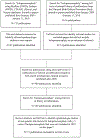Nongenetic risk factors for holoprosencephaly: An updated review of the epidemiologic literature
- PMID: 29761639
- PMCID: PMC6705603
- DOI: 10.1002/ajmg.c.31614
Nongenetic risk factors for holoprosencephaly: An updated review of the epidemiologic literature
Abstract
Holoprosencephaly (HPE) is a major structural birth defect of the brain that occurs in approximately 1 in 10,000 live births. Although some genetic causes of HPE are known, a substantial proportion of cases have an unknown etiology. Due to the low birth prevalence and rarity of exposure to many potential risk factors for HPE, few epidemiologic studies have had sufficient sample size to examine risk factors. A 2010 review of the literature identified several risk factors that had been consistently identified as occurring more frequently among cases of HPE, including maternal diabetes, twinning, and a predominance of females, while also identifying a number of potential risk factors that had been less widely studied. In this article, we summarize a systematic literature review conducted to update the evidence for nongenetic risk factors for HPE.
Keywords: cyclopia; diabetes; holoprosencephaly; sex ratio; twinning.
© 2018 Wiley Periodicals, Inc.
Conflict of interest statement
CONFLICT OF INTEREST
None.
Figures
References
-
- Anderson JL, Waller DK, Canfield MA, Shaw GM, Watkins ML, & Werler MM (2005). Maternal obesity, gestational diabetes, and central nervous system birth defects. Epidemiology, 16(1), 87–92. 10.1097/01.ede.0000147122.97061.bb - DOI - PubMed
-
- Billington CJ Jr., Schmidt B, Marcucio RS, Hallgrimsson B, Gopalakrishnan R, & Petryk A (2015). Impact of retinoic acid exposure on midfacial shape variation and manifestation of holoprosencephaly in Twsg1 mutant mice. Disease Models & Mechanisms, 8(2), 139–146. 10.1242/dmm.018275 - DOI - PMC - PubMed
-
- Browne ML, Rasmussen SA, Hoyt AT, Waller DK, Druschel CM, Caton AR, … Romitti PA (2009). Maternal thyroid disease, thyroid medication use, and selected birth defects in the National Birth Defects Prevention Study. Birth Defects Research Part A: Clinical and Molecular Teratology, 85(7), 621–628. 10.1002/bdra.20573 - DOI - PMC - PubMed
Publication types
MeSH terms
Grants and funding
LinkOut - more resources
Full Text Sources
Other Literature Sources


